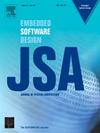智能城市环境的设计隐私AIoT愿景
IF 4.1
2区 计算机科学
Q1 COMPUTER SCIENCE, HARDWARE & ARCHITECTURE
引用次数: 0
摘要
AI(人工智能)的最新进展有助于促进AIoT(物联网人工智能)城市环境的发展。特别是机器视觉和图像分析,已经成为城市规划和监测领域广泛的人工智能应用中不可或缺的一部分。然而,人工智能算法在公共领域的迅速应用大大加剧了人们对隐私的担忧。在本文中,我们介绍了一种为智能城市系统量身定制的隐私设计方法,为开发和部署用于保护隐私的图像采集和分析的人工智能驱动系统提供了一种整体方法。具体来说,我们设计了一个嵌入式视觉系统,该系统可以获取受隐私保护的数据,保护敏感信息免受未经授权的访问和潜在的滥用。此外,我们提出了一种使用匿名数据开发人工智能视觉方法的策略,确保在整个人工智能应用程序构建过程中维护隐私。通过对现实世界中支持人工智能的城市环境用例(城市十字路口的交通流量监控)的实验,我们证明了我们的方法在保持现代人工智能视觉系统运行性能的同时,维护了强大的隐私保障。本文章由计算机程序翻译,如有差异,请以英文原文为准。

Privacy-by-design AIoT vision for intelligent urban environments
The recent advancements in AI (Artificial Intelligence) have been instrumental in fostering the development of AIoT (Artificial Intelligence of Things)-enabled urban environments. Machine vision and image analysis, in particular, have become integral to a wide array of AI applications within the field of urban planning and monitoring. Yet, the rapid adoption of AI algorithms in public areas has significantly heightened privacy concerns. In this paper, we introduce a privacy-by-design approach tailored for intelligent urban systems, presenting a holistic approach to the development and deployment of AI-driven systems for privacy-preserving image acquisition and analysis. Specifically, we design an embedded vision system that acquires privacy-protected data, safeguarding sensitive information against unauthorized access and potential misuse. Furthermore, we propose a strategy for developing AI vision methods using data that has been anonymized, ensuring that privacy is maintained throughout the AI application building process. Through experiments on a real-world AIoT-enabled urban environment use case – traffic flow monitoring at a city intersection – we demonstrate that our approach upholds strong privacy guarantees while maintaining the operational performance of modern AI vision systems.
求助全文
通过发布文献求助,成功后即可免费获取论文全文。
去求助
来源期刊

Journal of Systems Architecture
工程技术-计算机:硬件
CiteScore
8.70
自引率
15.60%
发文量
226
审稿时长
46 days
期刊介绍:
The Journal of Systems Architecture: Embedded Software Design (JSA) is a journal covering all design and architectural aspects related to embedded systems and software. It ranges from the microarchitecture level via the system software level up to the application-specific architecture level. Aspects such as real-time systems, operating systems, FPGA programming, programming languages, communications (limited to analysis and the software stack), mobile systems, parallel and distributed architectures as well as additional subjects in the computer and system architecture area will fall within the scope of this journal. Technology will not be a main focus, but its use and relevance to particular designs will be. Case studies are welcome but must contribute more than just a design for a particular piece of software.
Design automation of such systems including methodologies, techniques and tools for their design as well as novel designs of software components fall within the scope of this journal. Novel applications that use embedded systems are also central in this journal. While hardware is not a part of this journal hardware/software co-design methods that consider interplay between software and hardware components with and emphasis on software are also relevant here.
 求助内容:
求助内容: 应助结果提醒方式:
应助结果提醒方式:


